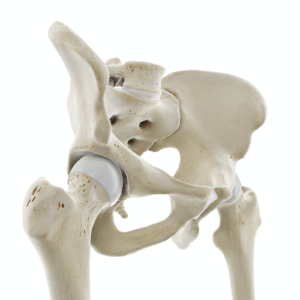
Surgical Options
Hip replacement and resurfacing are surgical treatments for arthritis. Learn more about Hip Arthritis and the available treatments, including surgery.
Hip Arthritis
Hip replacement/resurfacing are surgical treatments for arthritis. The hip is a ball-and-socket joint. In a healthy hip, the bone surfaces are covered with cartilage that enables the femoral head (the ball) to glide and rotate painlessly against the acetabulum (the socket).

In arthritis, the cartilage is missing or damaged and no longer functions normally. The bone surfaces start to come into contact with each other which causes pain and inflammation in the hip joint. This leads to decreased function as the arthritis worsens. The muscles and tendons around an injured joint also become very easily irritated and many people seek treatment for these various muscle pulls and strains in the early stages of hip arthritis.
As the arthritis worsens, a person becomes more and more limited in the activities that they can do comfortably. The joint usually becomes painful or gets painful with certain activities. Some people do not experience a lot of pain, they just notice decrease function. Most people experience a decrease in range of motion as the body’s response to this condition is to try to limit the motion at the arthritic joint. People find it difficult to put on their shoes and socks, or to do care on their toenails.
Muscles and the joint capsule that are not intermittently stretched to their maximum length start to develop a resistance to reaching those positions, we call this a contracture. A hip flexion contracture, which is very common in advanced hip arthritis, puts strain on the lower back as one tries to stand up straight, but the hip is not able to go into its normal range of motion.
Non-Surgical Treatment
Treatment involves treating the symptoms of arthritis. There are no known proven treatments that will restore the cartilage and give you back a normal hip joint surface. Once the cartilage is missing or damaged there is no good way to reverse it.
Treating the symptoms involves reducing pain and inflammation. Exercise is one of the best and most proven treatments for the symptoms of arthritis. Medications such as pain relievers, Acetaminophen, and anti-inflammatories, Aleve, Motrin, Celebrex, ASA can all help. Injections of cortisone or Hyaluronic acid (a joint lubricant) can help to reduce symptoms for a time. The goal of these treatments is to reduce pain so that one can participate in more activities and or do more exercises.
These non-surgical treatment options have various degrees of success in patients. Some people find significant improvement in their symptoms while others find no difference. It is very common for the symptoms to fluctuate over time and often with no identifiable explanation. Some people notice worsening symptoms with changes in the weather or increased stress in their lives, or with increased activities.
Candidates for Surgery

Patients with advanced hip arthritis may be candidates for surgical treatment. This depends on how much their lives are affected by the symptoms of arthritis. If there is minimal impact on function and lifestyle and a person is not experiencing much pain, they would not be considered surgical. Surgery involves significant risks and therefore should only be considered when the symptoms warrant it and the non-surgical options have been tried and have failed.
Someone who has had to give up most of their activities and is not able to be active due to the hip arthritis would be considered a surgical candidate. Exercise is one of the most important activities for good health and not being able to exercise regularly would make someone a potential surgery candidate. Some people experience severe pain, either during or after activities or even at nighttime and have trouble sleeping. These people are candidates for surgery.
Hip Surgeries
Hip Replacement
In a traditional total hip replacement, the head of the thighbone (femoral head) is removed and replaced with a metal stem that is placed into the marrow canal of the femur. A round ball of ceramic is placed onto the top end of the stem. The native socket (acetabulum) is sculpted or machined to remove any remaining cartilage and a metallic socket is secured into the space. A liner of plastic or ceramic is placed into the metal shell.
Candidates
Men older than 70, women older than 55.
Hip Resurfacing
In hip resurfacing, the femoral head is not removed, but is instead trimmed and capped with a metal or ceramic “cap”. The damaged bone and cartilage within the socket is machined and replaced with a metal or polyethylene or ceramic shell. Most of the current hip resurfacing devices are metal on metal. New ones are becoming available which use other materials.
Candidates
Younger and more active patients.